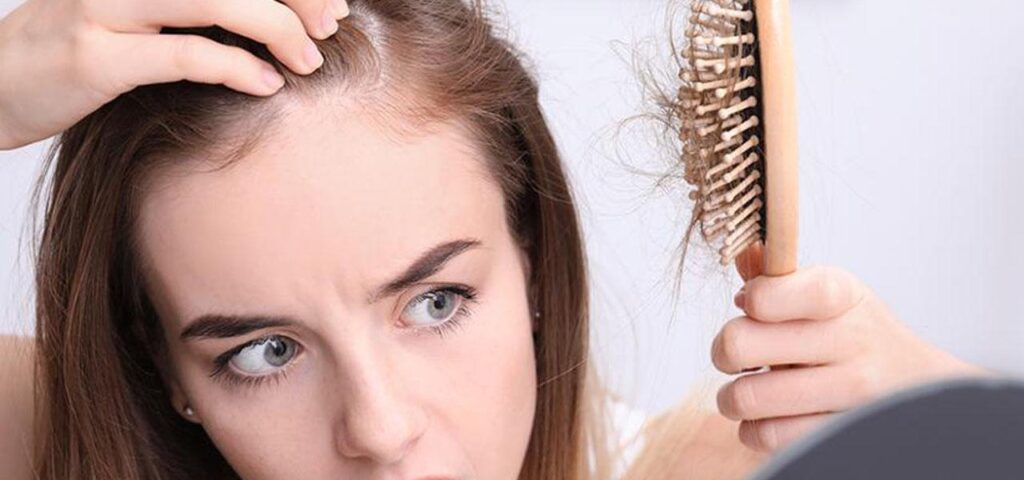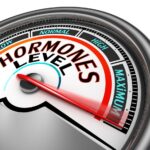Ferritin is a protein that stores iron in the body and gradually releases it when needed. Although it is most often analyzed in the context of diagnosing iron deficiency or anemia, it also plays a crucial role in scalp health and hair growth. For many patients, the problem of excessive hair loss may have a much deeper cause than hair care alone – one of the most commonly overlooked factors is low ferritin levels.
What role do iron and ferritin play in the hair growth cycle?
The hair life cycle consists of three main phases: anagen (growth), catagen (regression), and telogen (rest). Under normal conditions, most hairs are in the anagen phase, which can last several years and determines the length and density of the hairstyle. In cases of iron deficiency – and consequently low ferritin – the body may shorten the anagen phase, moving more hairs into the telogen phase. This leads to telogen effluvium, which manifests as excessive hair shedding, often in handfuls, especially when combing or washing the hair.
According to a study published in the Journal of Korean Medical Science (2013), women with ferritin levels below 30 ng/ml were significantly more likely to experience telogen hair loss than those with higher ferritin levels.
Hair follicles are highly sensitive to changes in metabolism and blood composition. They require proper oxygen supply and micronutrients, among which iron plays an essential role. When ferritin drops below a certain level (most often considered below 40–50 ng/ml), there is a lack of building material for keratin synthesis – the main component of hair. The effect? Thin, brittle, weakened hair that falls out faster than it grows back. See which tests to do if you experience hair loss
Low ferritin levels and hair loss – how to recognize it?
Hair loss caused by low ferritin often does not produce immediate, clear symptoms, so many people are unaware of the real cause of the problem for a long time. A typical warning sign is gradual but noticeable thinning of the hair, especially around the parting, temples, and crown. Hair becomes weaker, loses shine, breaks at the root, and tends to split. In extreme cases, visible scalp patches may appear where hair used to be dense.

Importantly, this type of hair loss can affect both women and men, although it is more often observed in women – especially during pregnancy, breastfeeding, heavy menstruation, or strict weight-loss diets. Vegetarians and vegans are also in the risk group, as well as people with intestinal diseases, autoimmune disorders, and those who regularly experience severe stress or chronic fatigue.
Ferritin diagnostics – when should you get tested?
Ferritin testing is quick, relatively inexpensive, and provides very important diagnostic information. In cases of suspected telogen effluvium or general hair weakening, ferritin measurement should be a basic part of blood tests, alongside morphology, TSH, vitamin D3, and levels of zinc and selenium. It is worth noting that ferritin, as an acute-phase protein, may be temporarily elevated during infections, inflammatory diseases, or cancer – therefore, results should always be interpreted by a specialist.
| Ferritin level | Hair loss risk | Recommendation |
|---|---|---|
| < 30 ng/ml | High | Urgent diagnostics and supplementation |
| 30–50 ng/ml | Moderate | Monitoring + growth support |
| > 70 ng/ml | Low | Optimal level for hair growth |
In the context of hair health, the optimal ferritin level often needs to be higher than the standard lower laboratory norms. Many trichologists and doctors specializing in hair loss recommend that ferritin levels should be at least 70–80 ng/ml if the goal is to improve hair condition and growth. In cases of clearly low ferritin, supplementation is necessary – but only after consulting a doctor.
Treatment and hair growth support in low ferritin
Treating low ferritin should not rely solely on iron supplementation – it is crucial to identify and eliminate the cause of the deficiency. This may include gastrointestinal bleeding, malabsorption disorders, vitamin deficiencies that support iron absorption (especially vitamin C), as well as chronic inflammation. Sometimes pharmacological treatment or lifestyle changes are necessary, especially in people with chronic stress or hormonal problems.
In hair loss caused by low ferritin, therapy should be multi-level. In addition to iron supplementation, therapies supporting scalp microcirculation should be introduced, such as scalp mesotherapy, carboxytherapy, or PRP treatments. These procedures improve oxygenation and nutrition of hair follicles, which, with the right ferritin level, allows the hair growth cycle to return to balance more quickly.
For patients with advanced alopecia where follicles have atrophied, the solution may be a hair transplant. Even in such cases, ferritin levels and overall body condition are important – preparing the body properly, including correcting deficiencies, increases the chance of better transplant results and proper scalp healing.
If you notice increased hair shedding, thinning, or weakened hair structure – don’t wait. Book a consultation at Piotr Turkowski’s clinic, where we will analyze possible causes of the problem, including ferritin levels, and propose solutions tailored to your individual needs.






